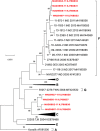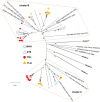Enterovirus detection in different regions of Madagascar reveals a higher abundance of enteroviruses of species C in areas where several outbreaks of vaccine-derived polioviruses occurred
- PMID: 36348312
- PMCID: PMC9641760
- DOI: 10.1186/s12879-022-07826-0
Enterovirus detection in different regions of Madagascar reveals a higher abundance of enteroviruses of species C in areas where several outbreaks of vaccine-derived polioviruses occurred
Abstract
Background: Poliomyelitis outbreaks due to pathogenic vaccine-derived polioviruses (VDPVs) are threatening and complicating the global polio eradication initiative. Most of these VDPVs are genetic recombinants with non-polio enteroviruses (NPEVs) of species C. Little is known about factors favoring this genetic macroevolution process. Since 2001, Madagascar has experienced several outbreaks of poliomyelitis due to VDPVs, and most of VDPVs were isolated in the south of the island. The current study explored some of the viral factors that can promote and explain the emergence of recombinant VDPVs in Madagascar.
Methods: Between May to August 2011, we collected stools from healthy children living in two southern and two northern regions of Madagascar. Virus isolation was done in RD, HEp-2c, and L20B cell lines, and enteroviruses were detected using a wide-spectrum 5'-untranslated region RT-PCR assay. NPEVs were then sequenced for the VP1 gene used for viral genotyping.
Results: Overall, we collected 1309 stools, of which 351 NPEVs (26.8%) were identified. Sequencing revealed 33 types of viruses belonging to three different species: Enterovirus A (8.5%), Enterovirus B (EV-B, 40.2%), and Enterovirus C (EV-C, 51.3%). EV-C species included coxsackievirus A13, A17, and A20 previously described as putative recombination partners for poliovirus vaccine strains. Interestingly, the isolation rate was higher among stools originating from the South (30.3% vs. 23.6%, p-value = 0.009). EV-C were predominant in southern sites (65.7%) while EV-B predominated in northern sites (54.9%). The factors that explain the relative abundance of EV-C in the South are still unknown.
Conclusions: Whatever its causes, the relative abundance of EV-C in the South of Madagascar may have promoted the infections of children by EV-C, including the PV vaccine strains, and have favored the recombination events between PVs and NPEVs in co-infected children, thus leading to the recurrent emergence of recombinant VDPVs in this region of Madagascar.
Keywords: Genotype; Human enterovirus; Madagascar; Vaccine-derived poliovirus.
© 2022. The Author(s).
Conflict of interest statement
The authors declare that they have no conflict of interests.
Figures







Similar articles
-
Genetic landscape and macro-evolution of co-circulating Coxsackieviruses A and Vaccine-derived Polioviruses in the Democratic Republic of Congo, 2008-2013.PLoS Negl Trop Dis. 2019 Apr 19;13(4):e0007335. doi: 10.1371/journal.pntd.0007335. eCollection 2019 Apr. PLoS Negl Trop Dis. 2019. PMID: 31002713 Free PMC article.
-
Co-circulation and evolution of polioviruses and species C enteroviruses in a district of Madagascar.PLoS Pathog. 2007 Dec;3(12):e191. doi: 10.1371/journal.ppat.0030191. PLoS Pathog. 2007. PMID: 18085822 Free PMC article.
-
High frequency of human enterovirus species C circulation in Madagascar.J Clin Microbiol. 2005 Jan;43(1):242-9. doi: 10.1128/JCM.43.1.242-249.2005. J Clin Microbiol. 2005. PMID: 15634978 Free PMC article.
-
[Eradication of poliomyelitis and emergence of pathogenic vaccine-derived polioviruses: from Madagascar to Cameroon].Med Sci (Paris). 2013 Nov;29(11):1034-41. doi: 10.1051/medsci/20132911021. Epub 2013 Nov 20. Med Sci (Paris). 2013. PMID: 24280508 Review. French.
-
Recombination between poliovirus and coxsackie A viruses of species C: a model of viral genetic plasticity and emergence.Viruses. 2011 Aug;3(8):1460-84. doi: 10.3390/v3081460. Epub 2011 Aug 17. Viruses. 2011. PMID: 21994791 Free PMC article. Review.
Cited by
-
Evaluation of Direct Detection Protocols for Poliovirus from Stool Samples of Acute Flaccid Paralysis Patients.Viruses. 2023 Oct 18;15(10):2113. doi: 10.3390/v15102113. Viruses. 2023. PMID: 37896890 Free PMC article.
-
Molecular Epidemiology and Evolution of Coxsackievirus A14.Viruses. 2023 Nov 26;15(12):2323. doi: 10.3390/v15122323. Viruses. 2023. PMID: 38140564 Free PMC article.
-
Monitoring the Risk of Type-2 Circulating Vaccine-Derived Poliovirus Emergence During Roll-Out of Type-2 Novel Oral Polio Vaccine.Vaccines (Basel). 2024 Nov 22;12(12):1308. doi: 10.3390/vaccines12121308. Vaccines (Basel). 2024. PMID: 39771970 Free PMC article.
-
Assessment of Enterovirus Excretion and Identification of VDPVs in Patients with Primary Immunodeficiency in India: Outcome of ICMR-WHO Collaborative Study Phase-I.Vaccines (Basel). 2023 Jul 6;11(7):1211. doi: 10.3390/vaccines11071211. Vaccines (Basel). 2023. PMID: 37515027 Free PMC article.
-
Factors Associated with Carriage of Enteropathogenic and Non-Enteropathogenic Viruses: A Reanalysis of Matched Case-Control Data from the AFRIBIOTA Site in Antananarivo, Madagascar.Pathogens. 2023 Aug 2;12(8):1009. doi: 10.3390/pathogens12081009. Pathogens. 2023. PMID: 37623969 Free PMC article.
References
-
- Bao J, Thorley B, Isaacs D, Dinsmore N, Elliott EJ, McIntyre P, et al. Polio—The old foe and new challenges: an update for clinicians. J Paediatr Child Health. 2020;56:1527–1532. - PubMed
-
- Kew O, Pallansch M. Breaking the last chains of poliovirus transmission: progress and challenges in global polio eradication. Annu Rev Virol. 2018;5:427–451. - PubMed
-
- Burns CC, Diop OM, Sutter RW, Kew OM. Vaccine-derived polioviruses. J Infect Dis. 2014;210(Suppl 1):S283–293. - PubMed
-
- Rakoto-Andrianarivelo M, Gumede N, Jegouic S, Balanant J, Andriamamonjy SN, Rabemanantsoa S, et al. Reemergence of recombinant vaccine-derived poliovirus outbreak in Madagascar. J Infect Dis. 2008;197:1427–1435. - PubMed
MeSH terms
Substances
Grants and funding
LinkOut - more resources
Full Text Sources
Medical
Research Materials
Miscellaneous

